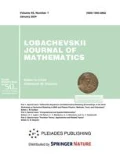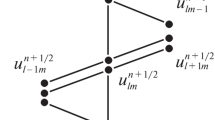Abstract
Numerical simulation of the surface ice accretion includes the work of various solvers that are performed iteratively and exchange data with each other. The calculation execution chain consists of the work of the gas-dynamic solver, the calculation of the liquid phase, the calculation of the thickness of the accreted ice on the surface grid and the rebuilding of the surface. After rebuilding is done, the modelling process goes to the next iteration in the gas-dynamic solver. Thus, the performance of a qualitative rebuilding of the surface computational grid taking into account the accumulated ice affects all further calculations. The article discusses approximate methods of rebuilding the surface mesh according to the ice accretion in each cell for the two-dimensional case and estimates their accuracy.
Similar content being viewed by others
References
Y. Bourgault, H. Beaugendre, and W. G. Habashi, “Development of a shallow-water icing model in FENSAP-ICE,” J. Aircraft 37, 640–646 (2000).
C. Bidwell, D. Pinella, and P. Garrison, “Ice accretion calculations for a commercial transport using the LEWICE3D, ICEGRID3D and CMARC programs,” AIAA Paper 99–0250 (AIAA, Reno, 1999).
A. Pueyo, D. Chocron, and F. Kafyeke, “Improvements to the ice accretion code CANICE,” in Proceedings of the 8th CASI Aerodynamics Symposium, Toronto, 2001.
A. Pueyo, D. Chocron, F. Mokhtarian, and F. Kafyeke, “CHT2D: A 2D hot air anti-icing analysis tool,” in Proceedings of the 50th Annual General Meeting (AGM) and Conference, Canadian Aeronautics and Space Institute, 2003.
S. Ozgen and M. Canibek, “Ice accretion simulation on multi-element airfoils using extended Messinger model,” Heat Mass Transfer 45, 305–322 (2009).
H. Beaugendre, “A PDE-based 3D approach to in-flight ice accretion,” PHD Thesis (McGill Univ., Montreal, QC, 2003).
J. Jiao, “Volume and feature preservation in surface mesh optimization,” in Proceedings of the 15th International MeshingRoundtable, Birmingham, AL (Springer, 2006), pp. 359–374.
D. Thompson, X. Tong, Q. Arnoldus, E. Collins, D. McLaurin, and E. Luke, “Discrete surface evolution and mesh deformation for aircraft icing applications,” in Proceedings of the 5th AIAA Atmospheric and Space Environments Conference, AIAA Paper 2013-2544 (2013).
A. Pueyo, “Efficient 3D artificial ice shapes simulations with 2D ice accretion codes using a 3-level correction,” in Proceedings of the SAE 2013 AeroTech Congress and Exhibition, SAE Technical Paper 2013-01-2136 (2013), Vol. 7.
G. Fortin, A. Ilinca, J.-L. Laforte, and V. Brandi, “New roughness computation method and geometric accretion model for airfoil icing,” J. Aircraft 41, 119–127 (2004).
G. P. Akilov and L. V. Kantorovich, Functional Analysis, 2nd ed. (Pergamon, Oxford, 1982).
S. Bourgault-Côté, K. Hasanzadeh, P. Lavoie, and E. Laurendeau, “Multi-layer icing methodologies for conservative ice growth,” in Proceedings of the 7th European Conference for Aeronautics and Aerospace Sciences EUCASS, 2017.
Funding
The work was done at the JSCC RAS as part of the state assignment for the topic 0065-2019-0016 (reg. no. AAAA-A19-119011590098-8). The supercomputer MVS-10P, located at the JSCC RAS, was used for calculations during the research.
Author information
Authors and Affiliations
Corresponding authors
Additional information
Submitted by A. M. Elizarov
Rights and permissions
About this article
Cite this article
Rybakov, A.A., Shumilin, S.S. Approximate Methods of the Surface Mesh Deformation in Two-dimensional Case. Lobachevskii J Math 40, 1848–1852 (2019). https://doi.org/10.1134/S1995080219110258
Received:
Revised:
Accepted:
Published:
Issue Date:
DOI: https://doi.org/10.1134/S1995080219110258




